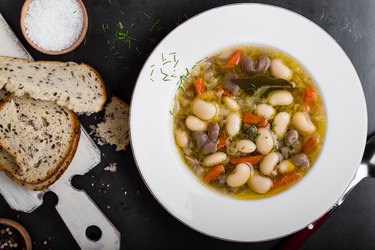
If there's one nutrient you should be eating more of, it's probably fiber. An estimated 95 percent of the U.S. population doesn't get enough fiber, according to January 2017 research in the American Journal of Lifestyle Medicine.
FYI, you should aim for around 22 to 34 grams of fiber per day, per the 2020-2025 Dietary Guidelines for Americans.
Video of the Day
Video of the Day
Sources of fiber include plant foods like fruits, vegetables, legumes, grains, nuts and seeds. But there are different types of fiber to consider — here's the difference between crude and dietary fiber and which category soluble and insoluble fiber fit into.
Related Reading
What Is Crude Fiber?
Crude fiber refers to the residue, such as cellulose and lignin, that remains after food is treated with acid and alkali during digestion, according to the National Academies of Sciences, Engineering and Medicine.
But the term is now considered nutritionally obsolete and isn't used anymore in nutritional guidelines. It may still be used in some cases, such as pet food and animal feed, but it's rarely used in relation to human nutrition and food.
"Crude fiber, a term that isn't used very often, is found in the cell walls of plants," says dietitian Taylor Winkel, RD. "It's also insoluble, meaning it will not be broken down by bodily processes."
If you're trying to eat more fiber, you don't have to worry about crude fiber in food. Dietary fiber is what you should be focused on.
What Is Dietary Fiber?
When you think of fiber found in food, that's dietary fiber.
Dietary fiber is defined as the components of plant foods the body can't easily absorb or digest, according to the Mayo Clinic. It's often referred to as roughage and helps support a healthy digestive system, but dietary fiber is important for overall health.
Though it's mainly thought of as a nutrient for digestion, dietary fiber isn't digested at all. It passes through the body largely intact. Its job is to help food move through the digestive tract so the nutrients can be absorbed.
"Dietary fiber is a type of carbohydrate within plant foods that is indigestible to humans," Winkel says. "There are two types of dietary fiber that we typically refer to, one being soluble and the other being insoluble."
- Soluble fiber: This type dissolves in water and thickens like a gel in our body, which slows digestion and helps individuals feel full quicker.
- Insoluble fiber: Unlike soluble fiber, it doesn't dissolve in water but instead stays whole and bulks your stool. This ultimately aids in keeping our bowel movements regular and prevents constipation.
It's important to get enough dietary fiber because it's linked to reduced risk of diseases like heart disease, type 2 diabetes and colon cancer, according to the Harvard T.H. Chan School of Public Health. Both soluble and insoluble are important for health, digestion and disease prevention, per the U.S. National Library of Medicine.
Foods high in soluble fiber include:
- Barley
- Nuts
- Beans
- Lentils
- Psyllium
- Oat bran
- Peas
- Seeds
- Apples
- Carrots
Foods high in insoluble fiber include:
- Vegetables
- Whole grains
- Wheat bran
- Cauliflower
- Potatoes
- Nuts
- Beans
Tip
Animal products like meat, fish, dairy and eggs don’t contain any fiber.
Fiber is only found in plant foods, so it’s important to eat a variety of vegetables, fruits, grains, legumes, nuts and seeds to meet your dietary fiber needs. Eating a variety of plant foods will help you meet your dietary fiber goals and help you get both insoluble and soluble fiber.
- American Journal of Lifestyle Medicine: "Closing America’s Fiber Intake Gap"
- USDA: "Dietary guidelines for Americans 2020-2025”
- National Academies of Sciences, Engineering and Medicine: "Recommended Dietary Allowances: 10th Edition (1989)"
- Harvard T.H. Chan School of Public Health: “Fiber”
- National Library of Medicine: “Soluble vs. insoluble fiber”
- Mayo Clinic: “Dietary fiber: Essential for a healthy diet”